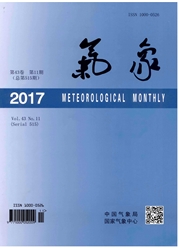

 中文摘要:
中文摘要:
针对2012年7月21—22日北京特大暴雨过程,比较WRF V3.5.1版本中KF、BMJ、GD、SAS四种积云对流参数化方案对降水的模拟效果,研究对流激发在时空分布上的特征以及预报降水量的影响因子。结果表明,KF方案整体效果较好,BMJ方案夸大了强降水区的范围和强度,GD和SAS方案模拟效果较差。各方案在初始对流激发的状态和时间上存在差异,使得演变过程显著不同。总体上,KF方案很好地模拟了对流的触发,在发生强降水时段,上升运动强,水汽条件充足。同时,KF和BMJ方案模拟的深对流区域降水效率高,SAS方案基本均为层云区域,无法模拟出强降水中心。
 英文摘要:
英文摘要:
Four cumulus convection parameterization schemes, i. e. , the Kain-Fritsch (KF), Betts-Miller- Janjic (BMJ), Grell-Devenyi (GD) and Simplified Arakawa-Schubert (SAS) schemes in the weather research and forecasting modeling system (WRF V3.5.1 version) are respectively used to simulate the severe torrential rain event in Beijing during 21-22 July 2012, particularly focusing on spatio-temporal features of convection bursts, and the impact factors of precipitation forecast. The results show that the simulated rainfall location and intensity by the KF scheme agree well with the observation while the BMJ scheme exaggerates the scope and intensity of the severe rainfall. The GD and SAS schemes have poor simulation results. The initial burst states and evoluting process of convection in the four schemes are quite different, and the forecast time is also different. Generally speaking, KF scheme performs better in simulating convection burst and it can simulate a strong upward motion and abundant moisture during the severe torrential rain period. Meanwhile, the rainfall rates in the simulated deep convection area are relatively high with KF and BMJ schemes. However, the simulated precipitation by SAS scheme is dominated by the stratus cloud area and it is unable to work out the center of the severe rainfall.
 同期刊论文项目
同期刊论文项目
 同项目期刊论文
同项目期刊论文
 期刊信息
期刊信息
